It’s crazy to think that a fortnight ago I’d just travelled 4,500 miles back from Delhi, after a whistle-stop tour around the north of India. Four days later I then travelled 250 miles from Reading to Hull, for a long weekend up north with friends.
A fortnight ago I was exploring the historical sites of Delhi, Agra and Jaipur in 40c+ heat. And then last weekend I was in the 10c sleety rain of Hull, exploring Holderness Road. Two very different places, and two very different weekends. Needless to say, I’ve been absolutely shattered this last week (hence the lack of recent posts). But now I’m back, and planning for my next trip.

Before I jetted off people who’d already visited the country forewarned me that I would I fall in love with India (I’ve been known to fall in love on my travels). They told me about the culture and colour, the history and heritage. From the at-times-overwhelming pace of life in its bustling cities, to its breathtaking temples and picture postcard scenery, I was told that few travellers ever leave disappointed.
They were right, of course.
The trip was everything I’d dreamed it would be, and more. Visiting the Taj Mahal had been on my bucket list for a while, but there were so many other amazing sights to see on the Golden Triangle tour – so if you’re making your own bucket list then definitely considering adding a few of them.
Travelling with my partner in crime, my 75-year-old grandma, I booked the entire package through The Holiday Place for just £749 each (including flights, accommodation and the tour). The tour started and ended in Delhi, and comprised of eight days exploring the Indian Golden Triangle with a representative from the SITA travel company. I’ve got a couple of more detailed posts to come, but here are a few snippets to whet your appetite…
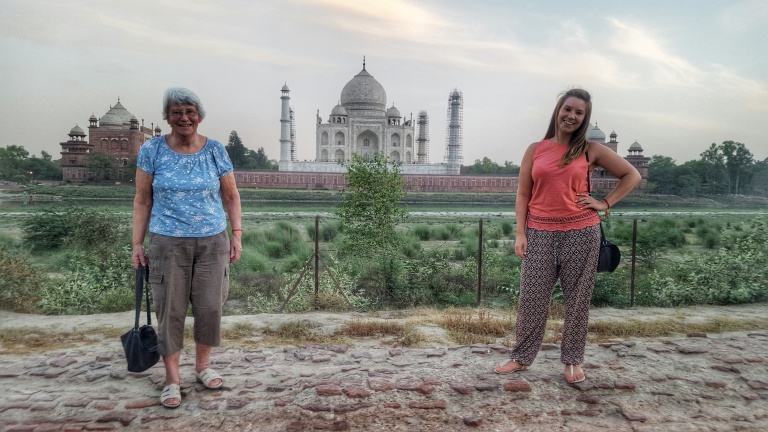
What is the Golden Triangle?
India’s Golden Triangle consists of the the three most visited cities in the country’s north-west: Delhi, Agra and Jaipur. They’re connected by good road and rail links, making a trip exploring all three more than doable in just a week. On the map they form a roughly equilateral triangle, about 130 miles along each side.
The route has been dubbed the “Golden Triangle” because of the extraordinary wealth of historical and cultural gems in each city. It’s a well-preserved haven of history, art, architecture and culture, amid the imposing modernity and urbanisation of the area. Mosques next to McDonald’s. and donkey-pulled carts next to brand new Mercedes. It is a country of all kinds of extreme.
If you only make one trip to India in your lifetime, I would heartily recommend a Golden Triangle tour – either as part of an organised group like me, or off your own back. The three cities are all very different, but you’ll get a taste into the culture and heritage the county is renowned for.
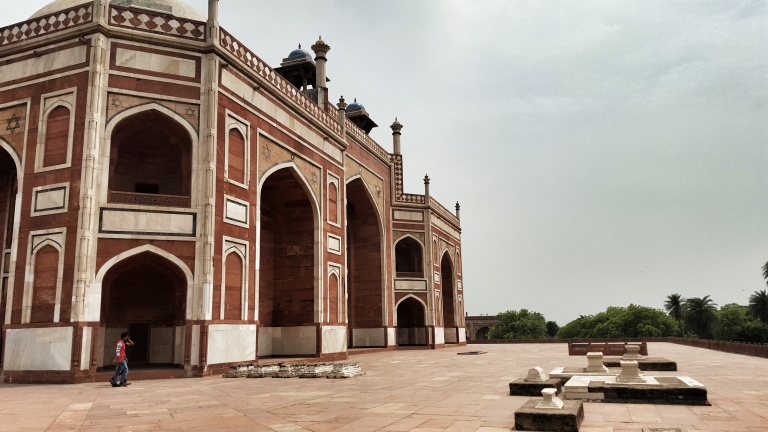
Delhi: the capital of India.
India’s capital, Delhi, is a major gateway to the country. The city itself is a bustling metropolis which combines the ancient with the modern. Amid the towering skyscrapers of the “New” quarter, are the remnants of a bygone time, in the form of temples, ruins and monuments, which stand proudly in the “Old” part of the city, as silent reminders to the region’s ancient legacy.
We spent two nights in New Delhi, staying at The Suryaa Hotel, with early starts and late finishes. It was tiring, but we crammed a lot in. The first day was a full tour of both Old and New Delhi. In Old Delhi we visited the immense 17th century Jama Masjid mosque, which dominates the quarter. After this we took a rickshaw ride through the narrow, winding lanes of the colourful and bustling Chandni Chowk bazaar. This was an experience to say the least.
After the madness, we took a quiet and thought-provoking stroll around the gardens at Raj Ghat, where Mahatma Gandhi was cremated. Our tour guide Dilip told us the story behind Ghandi, about his hunger strikes and his eventual assassination. It was a really interesting part of the tour, and the gardens were beautiful.

It was then back on the bus and into New Delhi, the more built-up, urban part of the city. En route we passed The Presidential Palace, the one-time imperial residence of the British viceroys, and then the India Gate, a modern memorial raised in honor of the Indian soldiers martyred during the Afghan war (pictured below). We then drove along the Rajpath, past the Parliament House and secretarial buildings – we couldn’t stop for pictures though (there are strict rules about this).
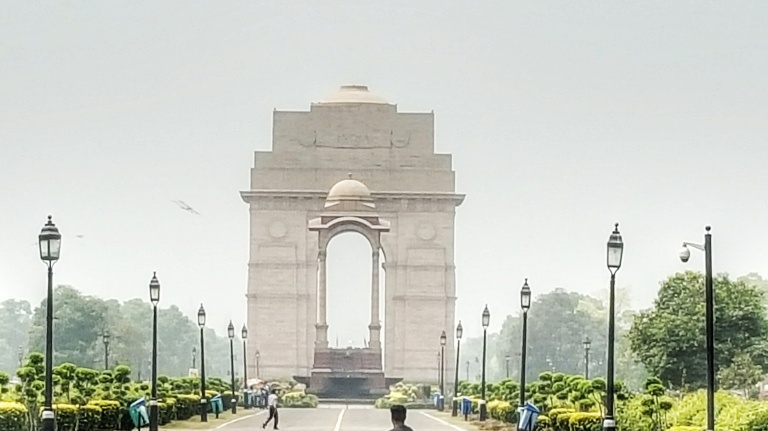
We then headed to the 16th century Humayun’s tomb, a precursor to the Taj Mahal. This was a really interesting place, with strong Persian influence, both in the structure of the buildings and the gardens. After we paid a visit to the Mughal Empire’s most renowned monument, the Red Fort.
In the early evening, as the sun began to set, we headed to Qutub Minar, the 12th century tower of victory built by a slave king (and prototype of all minars in India). With its red sand stone brick tower standing impressively at 72.5m high, this was my favourite part of Delhi. Dilip told us that the origins of the Qutab Minar are a bit of a mystery, with some believing it was erected as a tower of victory to signify the beginning of the Muslim rule in India, and others suggesting it served as a minaret to call the faithful to prayer. Whatever the reason it was built, you can’t dispute that the tower is not only one of the finest monuments in India, but also the world.
For all its dirt, traffic and crowds, the city’s biggest “sight” is, without doubt, its street life – and the experience of driving around Delhi was part and parcel of the tour. Though Delhi isn’t for everyone, neither the culture shock or hassle factor phased me. I think all but the most sensitive souls are likely to find a first visit to Delhi more inspiring than shocking.

Adventures in Agra.
The city of Agra came into the limelight during the rule of the Afghan King Sikandar Lodhi, who made it the capital of his empire. Later in 1526 AD, the Mughal Emperor Babar took it upon himself to transform Agra, giving it a unique character and beauty of its own. Over the next few hundred years, Agra witnessed the rise of the pomp and pageantry of three great Mughal monarchs – Emperor Akbar, Jehangir and Shahjahan. These made Agra what it is today.
Nowadays Agra is built around a thriving carpet industry, who make their wares among leather workers and sandstone and marble sculptors, many of whom claim to be direct descendants of the craftsmen who had helped build the Taj Mahal.
I’m not going to sugarcoat anything: for all its monumental splendour, Agra can be a trial. There’s a perpetual smog that hangs heavily, making the temperature in April almost unbearable. And then there are the hard-sell locusts that descend on you as soon as you step foot outside your hotel or clamber off the tour bus. Agra isn’t for everyone, but it’s a must if you want to visit the Taj. Which is worth the visit, obviously.
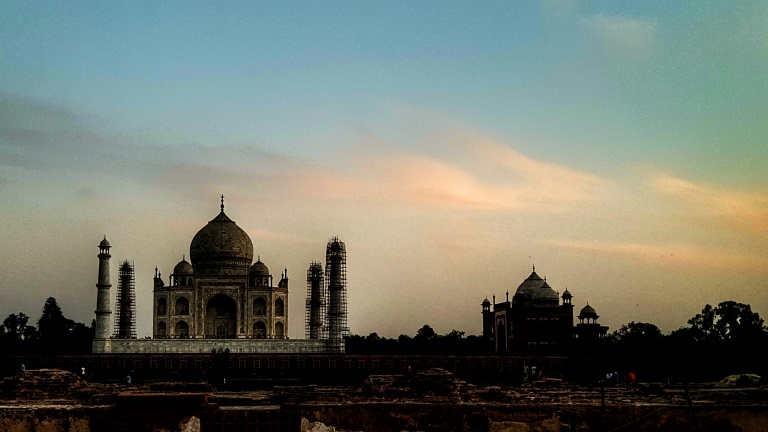
After the six hour journey from Delhi to Agra (made a little bit longer due to a mishap with Eddy leaving his bag in a restaurant en route, oh dear – luckily he got it back), we had a few hours to relax at our hotel – the DoubleTree by Hilton at Agra. This is one of the most beautiful hotels I’ve ever stayed in – chilling in the roof top pool, in the 44c heat, with a cold beer and a Taj Mahal backdrop was a very surreal experience.
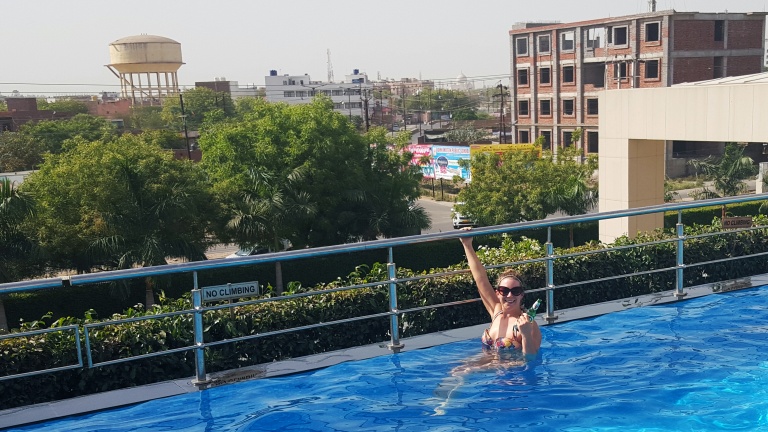
After soaking up a few rays, we took the bus to Mehtab Bagh, for amazing views of the Taj Mahal at sunset, surrounded by beautiful landscaped gardens. I got some amazing shots of the ever majestic Taj Mahal, as well as some pretty pictures of the Mehtab Bagh gardens, which were actually built as an integral part of the Taj complex. I also fell head over heels in love with two of the cutest puppies I’ve ever seen:

The next day we visited the Taj Mahal. Unfortunately I wasn’t feeling particularly great when I woke up, made even worse by it being the hottest day of the trip – so I skipped around the gardens as quickly as possible, then went inside with Rosemary, another lady on the tour.
The marble mausoleum is by far the most popular tourist site in India – and despite all the hype, it is an astounding and mesmerising building. On the inner walls there are jewel-like stones that create beautiful designs in the white marble. The Mughals perfected the art of embedding semi-precious stones into marble and the Taj is the finest example of this special process, called “pietra dura”. It begins with a marble plate, varying in size. Then jewels are sliced paper thin and embedded in the marble with such precision that the joints are invisible to the naked eye. I looked really hard, but I couldn’t find any joins. Amazing.
But Agra isn’t just about the Taj. It also offers other jewelled tombs and architectural marvels, as well as a medieval-like maze of ancient bazaars, a mass of hooting, tooting traffic, and some of the most acquisitive shopkeepers I’ve ever encountered. In the afternoon we headed to the Agra Fort, where the ageing Emperor Shah Jahan, imprisoned by his son, watched from a distance as his life’s dream was fullfilled -the building of the Taj Mahal, in memory of his beloved wife. Such a beautiful building, surrounded by such a sad story.
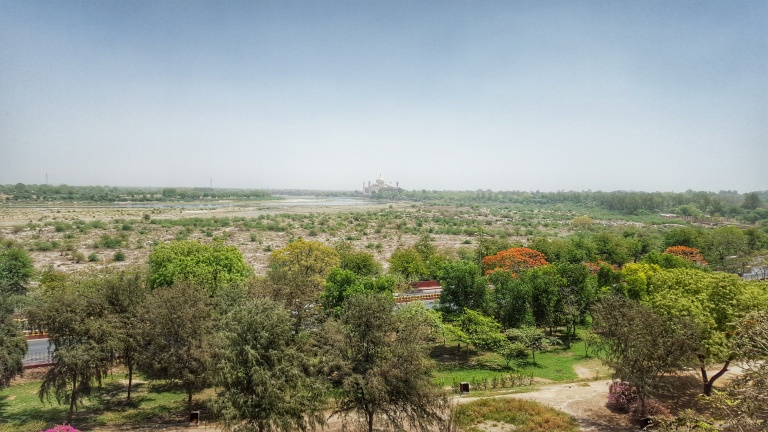
Seeing the sights in Jaipur.
Completing the triangle is Jaipur, the capital of the largely desert state of Rajasthan. The city’s frenetic old quarter is known as the Pink City after its red-washed buildings (more on that soon), and the streets are packed with stalls selling everything from milk to silk.
We spent two nights in Jaipur, staying at the Holiday Inn Express (which was pretty impressive compared to UK Holiday Inns). On the long drive from Agra to Jaipur, we stopped to visit Fatehpur Sikri.
Fatehpur Sikri is the deserted red sandstone city, built by the Great Mughal Emperor Akbar as his capital and palace in the late 16th century. It was abandoned soon after it was built when the local wells went dry, and it remains today in much the same condition as it was over 300 years ago. It is complete with palaces and mosques and used to be a town larger than London when it was originally constructed. Now it is an extraordinary place to wander around with its buildings in near perfect condition.
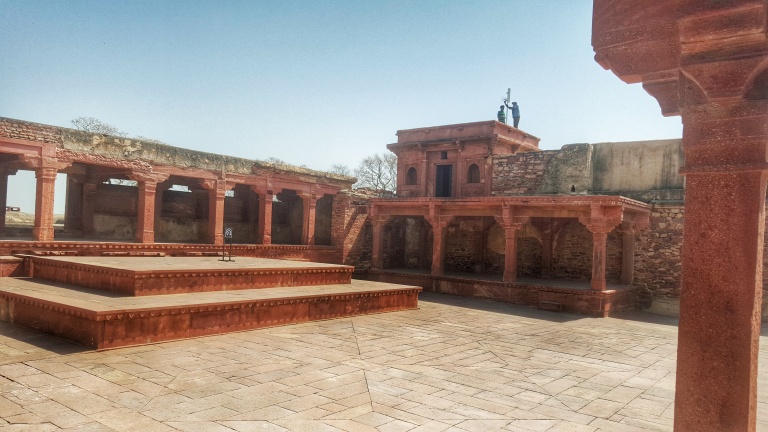
In the evening we were taken for a typically Rajasthani meal with a local family, where we were given a cookery lesson and taught how to make chapatis, pakora and green lentil dahl. It was amazing, and the family were really welcoming.
The next day it was another early start and a full-on day of sight seeing. Of Jaipur’s numerous monuments, the Hawa Mahal (also known as the ‘Palace of the Winds’) has become an icon of Rajasthani architecture. It is really an elaborate façade, extremely intricate in its pink sandstone carving. The cool wind blows through the façade of windows and latticed screens to the queens of the court, so they could look down on the streets of the city and watch as parades went past, without the public seeing them.
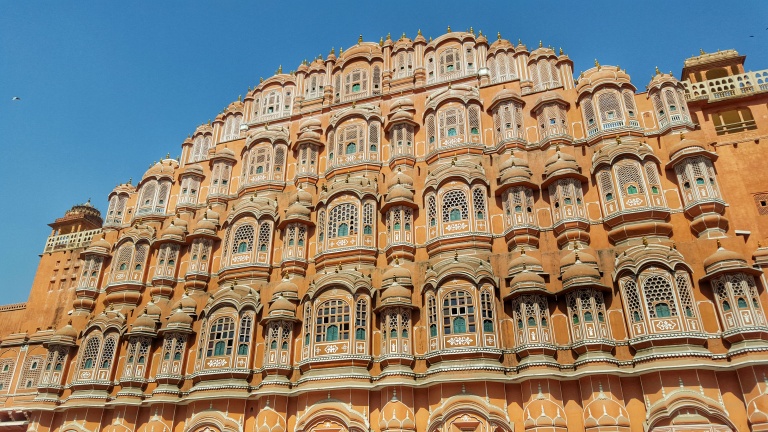
In the afternoon we visited the City Palace, which is an overwhelming complex of exquisite palaces, gardens and courtyards, decorative art and carved doorways. The palace museum houses collections of rare manuscripts, armory, costumes, carpets and miniature paintings. I learnt some really interesting facts from our tour guide while at the palace: who knew that both Chess and Polo originated from India?
Slightly different to the temples and palaces we’d been visiting, we then headed to Jaipur’s Jantar Mantar. It is the most famous of five observatories built by Sawai Jai Singh in India. Jai Singh was a great admirer of progresses and research made in the fields of science and technology, and he was passionate about astronomy. This observatory is considered the largest stone observatory in the world, and was really different to other things we’d visited.
We ended the tour of Jaipur on a high, with a trip to the fabulous Amber Fort. Maharaja Mansingh, Mughal Emperor Akbar’s most successful General, started the construction of Amber Fort in the 17th century. Before the City Palace was constructed in Jaipur, Amber was the seat of power. The fort is surrounded by fortified battlements and overlooks the Moat Lake. Ruins and remains are spread over the Aravali hills and sprawling walls lattice the surrounding area. An elephant ride to the top spared us the trouble of walking up to the steep road to fortress.
Once at the top, we strolled through the sprawling complex of courtyards and halls. Many of the rooms have delightful wall paintings, with precious stones and mirrors inlaid in the walls. Most fascinating, perhaps, is the Sheesh Mahal (hall of mirrors) where a single lamp is reflected in the many mirrors, lighting up the room. This was my favourite day of the whole trip, by far (and not just because I got to ride an elephant). Just look at this beautiful room in the Amber Fort:
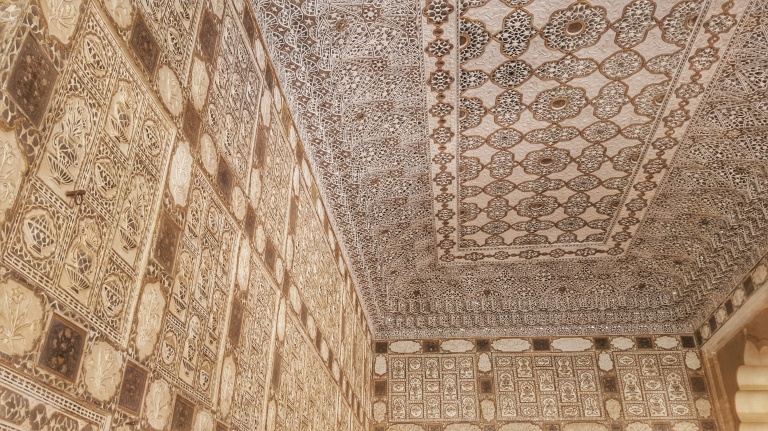
***
I’d like to say a huge thanks to Dilip, our amazing tour guide throughout India. He was so knowledgeable and very friendly, and even helped me out with some re-hydration salts and a big bottle of water when I wasn’t feeling great at the Taj Mahal. Also a big thanks to our bus driver, who navigated the precarious roads in Delhi without batting an eyelid or killing a cow. And the coach assistant for giving us numerous wet wipes and bottles of water throughout our mammoth journey, and for taking a shining to “Daadee”.
I couldn’t have asked for a nicer bunch of people to travel with either. Now, I wonder where my next adventure will take me…
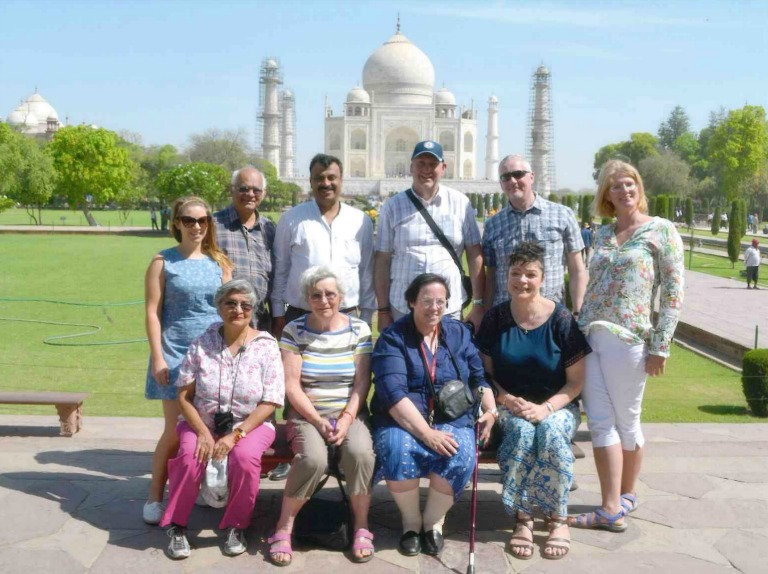

I am from Delhi & I loved reading your description about the cities. Often we Indians ourselves complain about heat, dirt & chaos but most of the foreigners overlook that and focus on what they have come for. I also have been to Agra & posted a few photos on my blog. You can check it out here (I don’t want to sound like I am advertising my blog. I just think you will love to see the pictures).
https://eyesmeetlenses.wordpress.com/tag/agra/
https://eyesmeetlenses.wordpress.com/tag/delhi/
LikeLiked by 1 person
Thank you Shashank! I’ll check out your blog now 🙂
LikeLiked by 1 person
Most welcome 🙂 You have an awesome travel blog 🙂 I love reading your posts!
LikeLiked by 1 person
That’s very kind of you to say – and likewise, your pictures are great!
LikeLiked by 1 person
Thanks for your kind words 🙂
LikeLiked by 1 person
You’ve certainly whetted my appetite!
Last October, we spent ten glorious days in Kerala (see http://channing.info/wp/2016/10/28/ten-days-in-kerala-days-1-2-kochi-cochin/ and following) – I cannot recommend it enough.
We have been considering going back at the end of this year, and are already talking to Tree Trunk Travel about their Golden Triangle offering.
LikeLiked by 1 person
Did you manage to make it on the Golden Triangle Tour Keith? Would love to see pics if you did? x
LikeLiked by 1 person
Wow this is amazing always wanted to go India and something I’m planning to do in the next two years so v helpful 🙂 x
LikeLiked by 1 person
This is an amazing post! I’m always fascinated by India, and this trip seems like a once in a lifetime thing. I really like how you incorporated the history of each place in the post too! It was so interesting to read!
LikeLiked by 1 person
Thanks for such a kind comment! I would definitely recommend India x
LikeLike
I am in love with these photos! I’ve always been toying with the idea of visiting India someday, this post is quite persuasive 🙂
LikeLiked by 1 person
I would definitely recommend this trip – its very well organised, and you see A LOT! x
LikeLike
Lovely photos. I can see you had a lovely time.
LikeLiked by 1 person
Wow, wow, wow! What a trip! It all looks absolutely incredible. No wonder you are exhausted but what memories you have. Kaz 🙂
LikeLiked by 1 person
WOAH. What a fantastic trip, such beautiful photos. I don’t know if it’d be for me though, I’m not very good with humdity!
LikeLiked by 1 person
Also on my to-d0 list one day. So sweet that you went with your granny!
LikeLiked by 1 person
So many lovely places in India! The Tash Mahal is def. on my list of things to visit before I die, it’s so beautiful and I love the back story to it.
LikeLiked by 1 person
Great read very informative. I find India a fascinating place. Thanks for posting.
LikeLiked by 1 person
This is an interesting post! I’ve always wanted to visit India, hopefully it’s in my near future!
LikeLiked by 1 person
I hope you make it there Sydney – it’s such an inspiring country! X
LikeLike
Oh my goodness, the golden triangle, this just looks like such an amazing place to explore – maybe one day!! Lovely pictures.
LikeLiked by 1 person
Thank you Rachel – I hope you make it there one day! x
LikeLike
What an amazing trip! I can’t believe you were able to book your travel at such a low price. Now you’ve got my travel juices flowing, I will have to see how much it is from the states.
LikeLiked by 1 person
Aww, I love the fact you are travelling with your grandma!!! You two seem just so adorable, exploring the big world together 🙂 Keep on and safe travels!
LikeLiked by 1 person
Ahhh thank you Petra – safe travels to you too! x
LikeLike
It looks dreamy! I hope I will visit India soon enough. Cultural heritage is huge there and so usual from europeans
LikeLiked by 1 person
It’s such a culturally diverse country – you’d love it Lyosha x
LikeLike
Lots of nice architecture there! I have seen already a lot photos from India, but it is first time I see the Palace of the Winds. Would love to get there with my camara
LikeLiked by 1 person
Yes, I can imagine you’d take some pretty great shots from there Alexander! x
LikeLike
Wow what a truly amazing blessing to be able to have this beautiful adventure! I would love to travel there someday.
LikeLiked by 1 person
It really was a blessing, and I was so lucky to have embarked on the adventure with my grandma 🙂 x
LikeLike
Your articles has brought back some sweet memories of my travel in India Golden triangle few years back. I really enjoyed the Taj Mahal white marbles and you are so lucky to have found a great spot,(at the side) to take the Taj Mahal ! I was entering from the main entrance and it was so crowded that my pictures were all photo bomb with other visitors. 🙂 Other favorite of mine is Hawa Mahal – it is really beautiful and it has so many windows for the curious royal females to peep at the guys who walk on the streets. Pretty funny and interesting culture!
LikeLiked by 1 person
India has been on my bucket list for awhile now and i have plans of visiting it soon. it seems you had an amazing time and thanks for sharing this, it gave me more reason to plan this trip.
LikeLiked by 1 person
India looks incredible. It seems like a once in a lifetime trip that you will remember forever!
LikeLiked by 1 person
I certainly will! x
LikeLike
This is such a great post and you describe everything so beautifully. What an incredible trip and I love the photos – the Hawa Mahal looks stunning!
LikeLiked by 1 person
Thanks Emily – have you ever been to India yourself? x
LikeLike
I hope you had a great time here. When I think of India I always have at least 15-20 days on my mind because there are so many things to see and I can’t decide what to do first. I love the picture of flowers that would be the heaven for my mum definitely because our house is full of plants and the picture with a dog is so cute – in that case that would be the heaven for me because I love animals so much. Thanks for sharing it! And the picture in front of Taj Mahal always remind me on a picture when the princess Diana was sitting there.
LikeLiked by 1 person
Yes, that’s the exact spot where Princess Di was for her famous photo – we had to queue for about an hour just to get these pictures haha! It’s so crazy and busy at the Taj Mahal. I preferred some of the other temples and mosques we visited, if I’m honest x
LikeLike
Becca, it’s so good to read your blog about India finally. I know you have been traveling there and I was actually waiting for this. Great! I am glad you loved your time there. Delhi, Agra and Jaipur are great, would you be detailing on each destination as well? I would love to read more details on Jaipur.
LikeLiked by 1 person
Hey Shreya, thanks for your comment! This is actually an old post, as I was in India in April 2016. However I have recently posted about my cooking experience in Jaipur, if you haven’t read it already: https://alwayscarryon.com/2018/02/12/indian-cookery-lesson/ x
LikeLike
You’ve certainly whetted my appetite! I have been to Delhi few times but always for work and never got enough time to visit all the must-see places. Jaipur is so beautiful. I like all your descriptions, so well explained.
LikeLiked by 1 person
Ahhh Preet, thanks so much for the kind comment 🙂 I hope you make it to Delhi for pleasure one day 🙂 x
LikeLike
India has always been a dream destination for me. Your explanation of the triangle gives me a great orientation of where to start. Love the photos and the mystical buildings you shared. They are calling to for me to sojourn ❤ Thanks! xo Evelyn, PathofPresence.com
LikeLiked by 1 person
I really think you’d love India Evelyn, I hope you make it there one day x
LikeLike
Sorry you weren’t feeling well for a part of your trip! The Taj Mahal has been on my bucket list forever.I’m jealous you saw it! I’ve never heard of the Golden Triangle though but this all looks like one for the books!
LikeLiked by 1 person
Thanks Ching – I wish I hadn’t been feeling so ropey for that part of the tour, as I think I would have enjoyed it a lot more if I wasn’t! x
LikeLike
I’ve always wanted to go to India and you made me want to go that much more! Great post.
LikeLiked by 1 person
Thanks Monique – I’m glad my post can inspire you x
LikeLike
Those buildings are so gorgeous! I’m so envious you got to go to India. I’m hoping to head there some day!
LikeLiked by 1 person
I hope you make it there one day Jennifer, it’s such an amazing country 🙂 x
LikeLike
The photos were great to look at! I hope to visit India one day. My former coworker is Indian and went to visit a couple of years ago and another friend went as part of his graduate school program. I hope to make it there because I really want to see all the great architecture.
LikeLiked by 1 person
The buildings I visited on the tour were absolutely beautiful, I must confess x
LikeLike
So that’s why my friend called it Daj, didn’t know it was an acronym for these 3 wonderful places. I actually fell in love right away looking at your night shot, wow! And that room from Amber Fort, just marvelous. I won’t forget these, I hope to travel to the Golden Triangle someday soon!
LikeLiked by 1 person
Ahhh thanks for your comment Esme 🙂 x
LikeLike
Looks like a great trip and I love that you travel with your grandmother! I’ve only been to 2 of the 3 cities in the Golden Triangle-have yet to visit Jaipur so I would love to go back to India.
LikeLiked by 1 person
Jaipur was probably my favourite place of the 3, so yes, I recommend you go back and explore some more x
LikeLike
I haven’t been to India yet. Since it’s such a huge country, I think that the golden triangle is a good orientation where to start and what to see. Very encouraging. I love your cute, personal pix 💗
LikeLiked by 1 person
Thank you Renata – I definitely recommend the Golden Triangle as an introduction to such a fabulous country! x
LikeLike
I’ve never been to India, but this looks like a place I should add to my bucket list. So beautiful and I love the architecture!
LikeLiked by 1 person
If you haven’t managed to make it there yet Jenny, I’d definitely recommend planning a trip 🙂 x
LikeLike
I really need to start saving up for some travel. Your photos are gorgeous!
LikeLiked by 1 person
Thank you Jen x
LikeLike
I’ve enjoyed so much reading about your tour, I didn’t know this three cities were called the golden triangle! It looks like a fantastic experiec, I would love to visit India at least once, when my children will be a little older 🙂
LikeLiked by 1 person
Yeah, it’s not really the kind of place I’d advice taking children, not during this time of year anyway – it was extremely hot! x
LikeLike
L0vely to read your post and good to know that you had a nice trip. Your post makes me visit my homeland. Beautiful photos too.
LikeLiked by 1 person
Where are you from in India Devajani? x
LikeLike